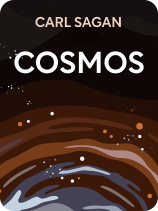

This article is an excerpt from the Shortform book guide to "Cosmos" by Carl Sagan. Shortform has the world's best summaries and analyses of books you should be reading.
Like this article? Sign up for a free trial here .
What is Carl Sagan’s book Cosmos about? What’s out there in the vast reaches of space? Are we alone in the universe?
Renowned astronomer Carl Sagan offers some insight into these questions and many more in his widely acclaimed book, Cosmos. In this book, he provides a comprehensive description of the science, philosophy, and history of astronomical discovery, from ancient Ionia to the time of the book’s publication in 1980.
Here’s a brief overview of Cosmos.
Cosmos Book Overview
The book Cosmos by Carl Sagan is an exploration of the universe. In this book, Sagan gives a comprehensive description of the science, philosophy, and history of astronomical discovery, from ancient Ionia to the time of the book’s publication in 1980. He discusses some of the obstacles posed by religious belief and institutions to scientific inquiry throughout history, and he celebrates the victories of the scientific endeavor. Although much research has been done in astronomy since the publication of Cosmos, the book remains timeless in the sense of wonder and awe it evokes. Sagan provides us with food for thought on some of the biggest questions pondered by humanity—questions about our place and significance in the vast universe.
Sagan was an American astronomer who spent most of his prolific career in Cornell University’s Laboratory for Planetary Studies. His 1977 book The Dragons of Eden, about the evolution of human intelligence, won a Pulitzer Prize. In the 1980s Sagan became a popular science writer and public figure, due largely to the success of Cosmos and the accompanying television show of the same name. His popularity continued following the publication of his 1985 science fiction novel Contact, which was made into a movie. Sagan died in 1996, leaving a vast body of intellectual and literary work as his legacy.
This guide will summarize the key ideas in Cosmos in three parts:
- In Part 1, we’ll summarize Sagan’s description of the evolution of life on Earth, and his thoughts about the possibility that a similar evolution could occur elsewhere, based on what we know about the universe.
- In Part 2, we’ll look at the history of humanity’s inquiry into the cosmos, outlining the astronomical discoveries made by important scientific figures.
- In Part 3, we’ll delve into Sagan’s theories about the possibility for interstellar travel, and the search for extraterrestrial life.
As this book was published in 1980, we’ll update the information with the scientific discoveries made since that time, as well as provide perspectives from other experts in related fields.
Part 1: The Vastness of Space and Time
In this section, we’ll discuss Sagan’s description of the vastness of the cosmos (or universe), and our place in it. We’ll begin by examining how life evolved on Earth to find our place within that timeline. After situating ourselves, we’ll zoom out to look at Sagan’s bigger picture of where Earth fits into the timeline and space of the universe. Ultimately, when we look at what’s known about the cosmos, we’ll discover that in the grand scheme of things, we’re pretty insignificant.
Humanity’s Place on Earth
Sagan begins the story of humanity’s history by teaching us that all life is made of carbon-based organic molecules, but there was once a time on Earth without life. How was it possible for life to come from non-life? Let’s look at a timeline of how that process occurred and discuss Sagan’s thoughts on whether the same thing could occur on other planets.
About 4.6 billion years ago, the Earth formed out of condensed gas and dust. The fossil record tells us life arose about 4 billion years ago, meaning that for 600 million years there was no life on Earth. According to Sagan, hydrogen-based molecules that are found throughout space were gradually broken down by the sun’s energy, and they formed into other more complex molecules—from one-celled plants to multicellular organisms. Sagan says that scientists have been able to replicate this on a much smaller scale in the laboratory. Scientists can create organic molecules that may have the potential to evolve into more complex life forms by exposing common inorganic gas molecules to an energy source, such as ultraviolet light. So, Sagan says, we know it’s possible to create living molecules from simple non-living gasses.
About 1 billion years ago, simple plants had evolved. Sagan tells us that for about 3 of the 4 billion years of life on Earth, the dominant life form was blue-green algae that covered the oceans. Those plants gradually changed the atmosphere by generating oxygen, allowing for many types of organisms to arise and others to die off. The process of evolution by natural selection gradually shaped these simple organisms into all of the life forms we know today.
About 10 million years ago, early hominids appeared, according to Sagan, with modern humans emerging only about 300,000 years ago. This means humans have existed for approximately .007% of the Earth’s history.
Evolution on Other Planets
Could life have evolved similarly on other planets? Sagan says it’s certainly possible. The gasses from which the first living molecules formed exist everywhere in the universe. However, for 3 billion years, life on Earth never evolved past blue-green algae, so Sagan points out that evolving large complex life forms is much harder than the origin of life itself. Therefore, he says that if there is life on other planets, it’s more likely to be simple organisms, because the time required to evolve complex intelligent life means that, statistically, the majority of life in the universe would be in some stage of evolution preceding the complex life form stage.
However, it’s certainly possible that there are some planets on which life has been evolving as long as it has been on Earth, or even much longer. Sagan speculates that life forms that have evolved much longer than humans may become extinct (for various reasons including self-destruction, which he argues is happening with humans), leaving only a relatively small time window, on the cosmic scale of time, for multiple forms of complex, intelligent life to exist simultaneously.
Sagan also points out that life elsewhere in the cosmos is probably nothing like we imagine, because our imaginations are limited by what we know. Given the many possibilities in the way molecules can combine, along with the vast possibilities for how characteristics could evolve, Sagan says that any life that has evolved elsewhere would most likely be out of our realm of imagination.
Earth’s Place in the Universe
While Earth seems special and central to our perspective, from the cosmic perspective it’s a minuscule piece of rock floating in a vast universe. To begin to understand just how vast the universe is, Sagan explains that distances between the celestial objects are so huge that we measure them in speed of light units. Light travels 6 trillion miles (10 trillion km) in one year, and a little over 11 million miles (18 million km) in one minute. Earth is 8 light-minutes away from the sun.
So, to understand our place in the universe as Sagan describes it, we’ll begin with Earth and zoom out. The Earth and our eight planet neighbors all orbit the sun, due to its gravitational pull. This is called our solar system.
Zooming out further from our own solar system, Sagan tells us that the sun is a relatively ordinary star that resides toward the outer reaches of the Milky Way galaxy. A galaxy is an enormous cluster of stars, all linked together by gravity. A typical galaxy has an average of about 100 billion stars, Sagan says, and the cosmos includes about 100 billion galaxies.
Our own galaxy, the Milky Way, is relatively large, containing about 400 billion stars. Sagan says that the majority of those stars could potentially have satellites (planets) revolving around them, as does our sun. He says that evidence would suggest that most probably do, which suggests hundreds of billions of potential planets in just our galaxy alone, not to mention the other 100 billion known galaxies.
If these numbers convey how vast the matter of the universe is, Sagan goes on to point out that despite the staggering number of stars and other orbiting objects in the universe, it actually consists of far more empty space than matter.
All of this considered, Sagan argues that we must conclude that we’re not that significant in the grand scheme of things. Not only is Earth’s place in the universe insignificant, but we humans are only one of innumerable possible forms of life, and even among the diverse life forms on Earth, we’re descended from blue-green algae, just like everything else. Sagan says that there’s no scientific justification for claiming that our place or position in the world is unique or special relative to anything else.
Despite this, he points out that many scientists have been persecuted and ostracized for making such claims. Next we’ll discuss some examples of those who have challenged the perspective of Earth-centered and human-centered privilege.
Part 2: History of Astronomical Thought
Humans in all places and times have been fascinated by the skies. We’ve used the stars to guide us, to mark the passage of seasons, and make sense of our place in the world for as long as we’ve existed. But our understanding of the nature and order of the universe, and our place in it, has evolved substantially over time. Sagan gives a historical picture of how humanity developed its beliefs “from chaos to cosmos.”
In this section, we’ll briefly outline the Western history of astronomical discovery, as presented by Sagan, from Thales of Miletus in ancient Ionia, to Isaac Newton in 17th-century England.
The Ionian Awakening
Sagan’s history begins between 600 and 400 BC, when a revolution of scientific thought occurred in Ionia, a Greek settlement on the Aegean coast in what is now Turkey. Ionia is often considered the birthplace of science, in the Western tradition. This revolution was sparked by a scientist named Thales of Miletus, who Sagan says was the first known scientist bold enough to attempt to explain the world without appealing to the supernatural. He explains that this had far-reaching consequences, as it prompted a shift from a world made by gods to a world made by natural processes.
Sagan details the revolutionary discoveries made during this time, including the idea that the sun was the center of the universe (heliocentric), rather than the Earth (geocentric). Copernicus is often given credit for the heliocentric model of the universe. However, Sagan says that Aristarchus is the first person known to have proposed that the Earth revolves around the sun, in Ionia, in 280 BC, 1800 years before Copernicus. Therefore, he points out that Galileo described Copernicus as “restorer and confirmer” of this worldview, not the originator of it.
Scientists in this period also proposed that the orbits of the planets were elliptical rather than circular, and that gravitational forces were at work in their orbiting of the sun.
According to Sagan, Aristarchus’ “great legacy” is the argument that we’re not special. He argued that humans are not the center of the universe, nor is our planet. This idea can be extended to many aspects of life—Aristarchus challenged the prevailing anthropocentric (“human-centered”) worldview. Sagan explains that this was a bold challenge to the social order, as it conflicted with a religious worldview that asserted that humans are uniquely created by the Gods, as well as with the idea of natural social hierarchies.
Alexandria
By the 3rd century AD Alexandria, Egypt had become the new center of scientific inquiry in the West. Around 285 BC, the Great Library of Alexandria was established as the world’s greatest repository of scientific knowledge and literature, though Sagan laments that most of the documents were lost when it was destroyed. He says that he has often wondered where we might be today (scientifically) if all of that knowledge hadn’t been lost.
Sagan explains that it was in Alexandria that Eratosthenes (276-194 BC) made the discovery that the Earth was round. And although this was resisted by many at the time, he points out that it was crucial knowledge for an accurate scientific understanding of how the celestial bodies operate, as well as solidifying a view of Earth as one among other spherical celestial bodies. This also paved the way for explorers who would brave the circumnavigation of the globe centuries later.
However, Sagan explains that much of the astronomical theory coming out of this time period was rejected in favor of the more-accepted Ptolemaic worldview. Ptolemy (100-170 AD), maintained that the Earth was the center of the universe, and the sun, moon, other planets, and stars moved around it, attached to invisible spheres. This model, Sagan says, was ultimately supported by the Church in the coming centuries, and because of that institution’s powerful reach, the Ptolemaic model lingered through the Middle Ages.
European Renaissance
When Europe began to emerge from what is known as the Dark Ages, the astronomical models we know to be correct today were developed. Here we’ll look at a brief timeline of discovery, as presented by Sagan, during the 16th and 17th centuries in Europe.
In 1543, Polish mathematician and astronomer Nicolaus Copernicus proposed his heliocentric model. In 1616 the Catholic Church placed Copernicus’ work on their banned books list, where it remained until 1835.
In 1571, German astronomer Johannes Kepler also came out in support of the Copernican heliocentric model. According to Sagan, Kepler was a religious man, but he thought a heliocentric model was more in line with religious beliefs. In his view, the sun was a metaphor for God, around which everything revolves. Sagan says that Kepler also calculated the elliptical orbits of the planets to explain their previously unexplainable movements. Because of these theories, Kepler was excommunicated by the Lutheran Church.
In the late 1500s, Italian astronomer Galileo Galilei made advancements to the existing telescope technology. Due to his more powerful designs, he was able to discover the four largest moons of Jupiter, and the craters of the moon. Galileo also adhered to the heliocentric model.
In the 1600s, Isaac Newton discovered the law of gravity, which Sagan tells us was able to solidify the explanation of how the planets revolve around the sun, and the moons around the planets. Sagan says that Newton’s discoveries and the laws of nature derived from them, laid the foundation for our current understanding of the universe.
Part 3: Exploration of Space
Now that we have a solid working model of the universe, and have been able to directly observe much of it via telescopes, we move into the age of physical exploration. We’ll begin with discussing what modern astronomers have discovered about the celestial bodies in our own solar system, then look at the potential that lies beyond our solar system. Sagan offers some insightful views on the potential for interstellar travel and for discovery of life on other worlds.
Our Solar System
On July 20th, 1969, humans made the first trip to a destination off the planet Earth and set foot on the moon. The moon is the nearest celestial body to us, and it remains the only one humans have ever traveled to. However, Sagan explains that we’ve been able to create vehicles that can travel much further, enduring the inhospitable climates elsewhere in the solar system, and send information to us.
At present, Sagan says that none of the atmospheres and climates of the other bodies in our own solar system are inhabitable by anything like the kind of life we have here on Earth. But he reminds us that life could take any number of forms, and because it would have evolved in a different atmosphere than ours, it could take forms that we might not expect.
Looking for Life on Mars
So far, Sagan explains, we’ve been able to fairly extensively study the Moon, Mars, Venus, Jupiter and its moons, and Saturn and its moons. Sagan says that Mars has been the primary focus of study because its polar caps are covered with ice—which means there’s the possibility that it was once liquid water, which in turn denotes the possibility for life.
As of the writing of this book, Sagan says that no compelling evidence for life has been found on Mars. However, he says we’ve been able to map the entire planet with orbiting satellites, and the US’s Viking lander has successfully landed on its surface and collected and tested soil samples. While some of the microbiology tests showed promise of chemical reaction, Sagan says there was no definitive evidence of the kind of life we know.
Sagan speculates on what we should do if we did discover any form of life on Mars. He strongly feels that if we discover even the smallest microbial life we should leave Mars alone entirely, and do nothing more to interfere with it. However, he says if we conclude that there is no life on Mars, he can imagine possibilities for humans to colonize and settle there, after altering the atmosphere.
The Space Probes
Spacecraft called Voyager I and II were designed to explore beyond our immediate neighbors. Launched in 1977, their mission was to fly beyond Mars, travel among the moons of Jupiter and Saturn, and then ultimately drift off into interstellar space forever.
Sagan tells us that Voyager I took pictures of three of Jupiter’s four largest moons, and Voyager II was able to capture photos of the fourth one, Europa. Europa is unique, he says, in that there are visible geometric lines on its surface that look like nothing else we know of, other than man-made canals.
Another one of Jupiter’s moons, Io, is unique in that the Voyager images show active volcanoes over much of its colorful surface. Sagan says this appears to be a newer planet still actively forming, with a rapidly changing landscape. (Shortform note: See a photo and more in-depth description of Io here.)
Beyond Our Solar System
Even with the ability for travel within our solar system being limited, Sagan points out that humans still dream of going further, and he thinks we always will. Since we haven’t found any evidence of a habitable environment within our solar system, might there be some in other solar systems?
We don’t know how many planetary systems might exist in the cosmos. Sagan says the evidence suggests that almost all single stars like the sun should have satellite planets, but we can’t see them because the light of the stars is too bright. He says scientists are working on telescope technology that could dim the light so they might be able to see the much smaller objects orbiting the stars. Also, he says that in addition to “planets” orbiting stars, Jupiter, Saturn, and Uranus all have satellite “moons” that are planet-like, so many other planets could have such satellites as well. So there are innumerable possibilities for other worlds that could sustain life.
Interstellar Travel
Alpha Centauri is the closest “star” to us, being 4.3 light-years away, but Sagan explains that it’s actually a triple star system. Considering the vast distance, will it ever be possible to travel to other solar systems? Sagan suggests that nuclear fusion technology might make it possible to power spacecraft fast enough. However, he explains that such technology would require the spacecraft to be launched from Earth’s orbit, rather than from land, because of the dangers involved with the nuclear fusion reaction.
Sagan says the technology to build a ship that can travel anywhere close to light-speed is probably thousands of years away, but a ship using nuclear fusion technology may be able to travel about 10% the speed of light. With Alpha Centauri being 4.3 light-years away, a voyage there would take 43 years, meaning it would be feasible for humans to travel there within a lifetime. But he proposes that to travel any further, we might need “multigenerational” spacecraft, where generations of humans would be born and live their lives, so that subsequent generations might reach other solar systems.
Considering the scientific discoveries being made in Ionia over 2,000 years ago, Sagan believes that we might be there right now if that scientific inquiry had not been suppressed by religious forces for centuries.
The Search for Extraterrestrial Life
The idea of intelligent life existing on other planets is probably the most powerful driving force of humanity’s exploration of the cosmos. It’s the theme of countless works of human imagination, from books and poetry to movies and television. Sagan believes the evidence would suggest it’s far more likely than not that there’s some kind of life out there in the universe; he says there could realistically be a hundred billion planetary systems in the galaxy, and each and every one of them would be unique.
According to Sagan, the same kind of evolutionary process that happened on Earth should logically operate everywhere in the universe. But with the number of possibilities of how that would unfold in a hundred billion unique environments, he thinks any life that may have evolved would probably be nothing like humans, or any kind of life we know.
Scientists have been intentionally trying to communicate with other potential life in the universe since the 1970s. Sagan says that we have the technology to communicate over interstellar distances; it’s called radio astronomy. Radio waves travel at the speed of light. The Arecibo Observatory in Puerto Rico has been searching continuously for any radio waves coming from outer space, and Sagan says that it once broadcast a message into space, directed toward a distant star cluster called M13.
Humans have created many imagined scenarios in film and literature depicting the arrival of alien life on Earth. In pondering this possibility, Sagan says that one thing is clear: There’s no cause to worry about what we would do if extraterrestrial beings arrived here on Earth. Because if that happened, they’d be so technologically beyond us that there would be nothing we could do. He also hypothesizes that any species that has survived long enough to develop such technology has probably learned how to live effectively and peacefully with themselves and others, or they would have destroyed themselves already, as humans may be in danger of doing.

———End of Preview———
Like what you just read? Read the rest of the world's best book summary and analysis of Carl Sagan's "Cosmos" at Shortform .
Here's what you'll find in our full Cosmos summary :
- Carl Sagan's insights into some of the universe's biggest questions
- The history of astronomical discovery, from ancient Ionia to 1980
- Why humans will need “multigenerational” spacecrafts to explore space






